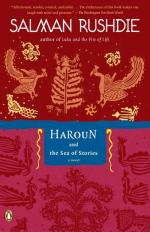|
This section contains 9,083 words (approx. 31 pages at 300 words per page) |

|
SOURCE: Teverson, Andrew S. “Fairy Tale Politics: Free Speech and Multiculturalism in Haroun and the Sea of Stories.” Twentieth-Century Literature 47, no. 4 (winter 2001): 444-66.
In the following essay, Teverson identifies Rushdie's two main objectives in Haroun and the Sea of Stories—“to reassert the value of storytelling after the fatwa, and to defend free speech against what he sees as the forces of silence and oppression.”
Jacobites must speak in children's rhymes, As preachers do in Parables, sometimes.
—Pynchon (350)
Late in his life, either in the latter decades of the twelfth century or the first decades of the thirteenth, there is evidence that Farid ud-Din Attar, the Sufi mystic and poet, fell afoul of the Persian authorities and was charged with heresy. He had, according to Edward G. Browne, “aroused the anger and stirred up the persecuting spirit of an orthodox theologian” who denounced him as “a heretic deserving...
|
This section contains 9,083 words (approx. 31 pages at 300 words per page) |

|


